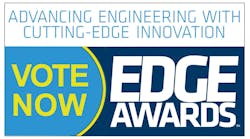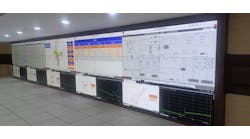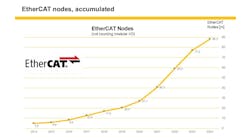“In a system where one thing is controlling another thing, plug and play is based on standardized interfaces. It helps to think of OPC-UA communications as the road, NAMUR as the car, and our data model as what's inside the car." Rockwell Automation’s Bruce Kane explained the life science industry movement to develop process automation system components that readily plug-and-play, or interoperate, with one another.
Is plug-and-play process automation possible in the life sciences industries? Maybe, but everyone involved has to agree on a few things first.
The ongoing takeover of microprocessors, software, Ethernet networking, the Industrial Internet of things (IIoT), big data, cloud computing and other forms of digitalization make all kinds of efficiencies and performance gains possible, but getting all their disparate parts to communicate and hopefully interoperate remains difficult and often impossible. What's needed are standardized communications, software and data models on compatible devices—but those have been elusive, too. Until now.
One of the main plug-and-play efforts in the life sciences industry is being carried out by the BioPhorum Operations Group (BPOG) and its technology road-mapping forum, according to members Bruce Kane, PE, global life science technical consultant, Rockwell Automation, and Jason Doherty, systems architect, GE Healthcare-Life Sciences. They presented "BioPhorum Plug and Play" at Rockwell Automation’s Process Solutions User Group (PSUG) meeting this week in the run up to Automation Fair 2019.
BPOG consists of more than 82 member companies, more than 2,800 active participants, and seven "phorums" including those focused on cell and gene therapy, drug and substance, development, fill and finish, supply partner, information technology and technology road-mapping.
"Life sciences manufacturing environments were traditionally stick built with static, purpose-built installations, low flexibility and high costs," said Kane. "We've been moving to single-use technology for batches, but now users want more flexibility and the ability to change out components and systems. Once a production line is put together, and there's a problem or users want to exchange a 500-liter bioreactor for a 1,000-liter bioreactor, they should be able to do it easily.
"Users just want bioreactors from different manufacturers to behave the same, but it's a challenge to get there because they've lacked standardization and been costly to rebuild. This is why our road-mapping group has been working on a plug-and-play model."
Define and standardize
Kane reported the plug-and-play project has been pursuing three primary ways to implement standardization across requirements and functional components of equipment operations. These include:
- BioPhorum Plug and Play, which has developed common definitions of profiles and respective functions for biopharmaceutical equipment, such as bioreactors, chromatographs and normal flow filtration (NFF) devices.
- International Society for Pharmaceutical Engineering (ISPE) Plug and Produce, which brings in good manufacturing practices (GMP) for data storage and integrity, time synchronization and user management.
- The NAMUR user association of automation technology in the process industries, and its Model Type Package (MTP) framework, covering data structures such as interfaces, state models, and services to interact with modules.
"NAMUR defines a distributed control system (DCS) as a supervisory process orchestration layer (POL) with drives and services running on process equipment assemblies (PEA) like skids or other equipment," explained Kane. "Next, NAMUR looks at integration points between those POLs and PEAs. These points can include ISA-88 (batch) integration, visualization, alarming or reporting functions."
Meanwhile, MTP is based on modular automation principles, which allow process modules and functions to be expressed as software objects. These MTPs are vendor-neutral, contain functional information, and can be imported and exported using Automation Markup Language (AML). "For example, vendors can download skid configurations, export them to MTP file formats, and the POL of the host system can run the equipment."
Joining the batch?
Kane reported that NAMUR and MTP can jibe with the well-known ANSI/ISA-88 batch process control standard and its established methods because all of S88's procedural elements can be mapped as MTP services. "In a system where one thing is controlling another thing, plug-and-play is based on standardized interfaces," he said. "It helps to think of OPC-UA communications as the road, NAMUR as the car, and our data model as what's inside the car. That model has to be at both the device and supervisory level, so the common definitions can allow the services to interact. As long as they follow the rules, a DCS or manufacturing execution systems (MES) could drive these services."
Kane added BioPhorum's Plug and Play project has been evaluating the basic requirement for using MTP-based devices and services, but hasn't yet examined NAMUR's orchestration layer—although it may prove suitable for allowing process units to talk to each other.
Finding, capturing value
Doherty reported GE Healthcare has developed a proof-of-concept to identify the benefits and value that standardized, plug-and-play process automation could generate for it and other BioPhorum members, and has already decided to adopt NAMUR's principles.
"Plug and play can enable faster automation system development reconfigurations; eliminate development costs for custom interfaces; give users the flexibility to easily switch between unit operations; provide better contextualization from standardized report data; and improve quality by reducing the need for testing and validation," said Doherty. "The value of flexibility and standardization is that equipment can be simply configured—rather than programmed—for a specific application."
Doherty added that plug-and-play can also streamline validation by allowing users to perform formerly sequential activities concurrently. "Implementing standards can let us do the full design and development on a skid before it's built, and that would be a big savings," he said.
"Standardized communications also cuts costs,” Doherty said. "We're planning to complete our case study this year, and we'll be able to show some potential savings after that. However, we've already estimated that plug and play could save six months of scheduling on a typical project and save $60,000 just on developing its interfaces."
The editors of Control are on-site at Automation Fair 2019 to bring you breaking news, innovations and insights from the event. Once the event is over, they will put together a report featuring the top news. Pre-order your copy today.







